Elnath (Beta Tauri): Star Type, Name, Location, Constellation | Star Facts (original) (raw)
Elnath, Beta Tauri (β Tau), is a blue-white giant star located in the constellation Taurus. With an apparent magnitude of 1.65, it is the second brightest star in Taurus, after Aldebaran, and the 27th brightest star in the sky. It is only slightly fainter than Shaula in the constellation Scorpius, Gacrux in Crux and Bellatrix in Orion, and it just outshines Miaplacidus in Carina, Alnilam and Alnitak in Orion, and Alnair in Grus.
Elnath lies at a distance of 134 light years from Earth. It marks the tip of the celestial Bull’s northern horn and is one of the bright stars that form the hexagon asterism that dominates the neighbouring constellation Auriga. Due to its location on the border between Taurus and Auriga, Elnath was once also known as Gamma Aurigae.
Elnath is a chemically peculiar star of the spectral type B7 III. The stellar classification indicates a giant star appearing bluish or blue-white in colour. The star has a mass about five times that of the Sun and has expanded to a size of 4.2 solar radii. With an effective temperature of 13,800 K, it shines with 700 solar luminosities. Elnath spins faster than the Sun, with a projected rotational velocity of 59 km/s. Its estimated age is about 100 million years. In another couple of million years it will evolve into a larger and cooler orange giant star.
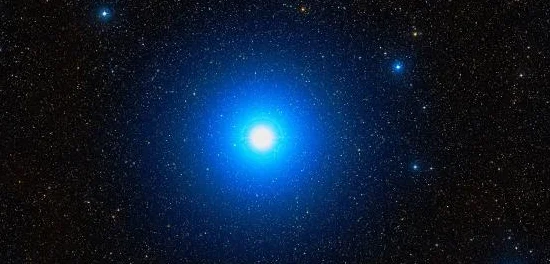
Elnath (Beta Tauri), image: Wikisky
Elnath is a mercury-manganese star, a chemically peculiar star with prominent lines of heavy elements in its spectrum. It has a high abundance of manganese compared to the Sun, but does not show a high mercury signature. This, combined with the star’s prominent lines of silicon and chromium, has led some researchers to classify it as a SrCrEu star or an Ap star.
Elnath has the designation WDS J05263+2836A in the Washington Visual Double Star Catalog. It has a faint visual companion at a separation of 33.4 arcseconds. There are six other fainter stars appearing closer to Elnath, but they are believed to lie at a greater distance.
Facts
Elnath and its brighter Taurus neighbour Aldebaran are among the 58 stars that have a special status in the field of celestial navigation. Navigational stars are some of the brightest and most identifiable stars in the sky. They were selected by Her Majesty’s Nautical Almanac Office (HMNAO) and the US Naval Observatory. The selection consists of 19 first-magnitude stars, 38 second-magnitude stars, and Polaris, the North Star.
The German uranographer Johann Bayer assigned Elnath two designations: Beta Tauri and Gamma Aurigae. Both Bayer and Ptolemy before him considered the star to be shared by the constellations Taurus and Auriga. The designation Gamma Aurigae stopped being used when the constellation boundaries were defined in 1930.
In Arabic astronomy, the star was known as Al Ka’b dhi’l Inan, meaning “the heel of the rein-holder.” The name referred to the star’s position in Auriga. In later Arabic astronomy, the star was called Al Karn al Thaur al Shamaliyyah, the Northern Horn of the Bull.
In Babylonian astronomy, Elnath was known as Shur-narkabti-sha-iltanu, roughly translated as the “star in the Bull toward the north” or the “north star toward the chariot.” (The chariot is part of the constellation Auriga, the Charioteer.)
Elnath is located only 5.39 degrees north of the ecliptic, the Sun’s apparent path across the sky. As a consequence, the star can be occulted by the Moon. However, most occultations can only be observed from the southern hemisphere due to the star’s location at the northern end of the lunar occultation zone. The next occultation will occur on September 7, 2023.
Elnath has similar properties to Maia (spectral class B8III), one of the brightest stars in the Pleiades cluster (Messier 45). However, even though Maia is a bit larger (6.04 R☉) and more luminous (850 L), it is also considerably more distant at about 400 light years, and therefore appears much fainter (mag. 3.871) than Elnath.
Elnath was memorably referenced in the episode “The Galileo Seven” (1967) of Star Trek: The Original Series. In the episode, Spock is pulled off course during a mission and must make an emergency landing on Taurus II, a planet orbiting Beta Tauri.
Name
The name Elnath (pronunciation: /ˈɛlnæθ/) is derived from the Arabic an-naţħ, meaning “the butting” (the bull’s horns). The name has also been spelled El Nath and Alnath. It was once also used for Hamal, the brightest star in the constellation Aries.
The name was approved by the International Astronomical Union’s (IAU) Working Group on Star Names (WGSN) on July 20, 2016. It formally applies only to the component Beta Tauri Aa.
The Chinese know Elnath as 五車五 (Wǔ Chē Wǔ), the Fifth of the Five Chariots. Five Chariots is a Chinese asterism formed by Elnath with Capella (Alpha Aurigae), Hassaleh (Iota Aurigae), Menkalinan (Beta Aurigae), and Mahasim (Theta Aurigae).
Location
Elnath is very easy to find because it forms a prominent hexagon pattern with the brightest stars of the constellation Auriga. It is located right on the border between Taurus and Auriga, only about 3 degrees west of the galactic anticentre, located in Auriga. Elnath is the nearest bright star to the galactic anticentre, which lies at the opposite end of the sky to Sagittarius A, the radio source believed to mark the location of the supermassive black hole at the centre of the Milky Way.
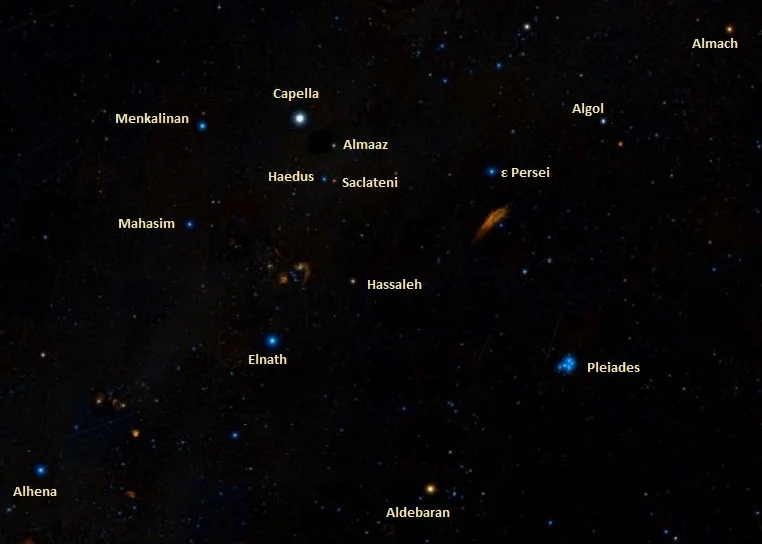
Elnath location, image: Wikisky
Elnath is visible at some point in the night throughout the year with the exception of June, when it is too close to the Sun.
The star lies in the vicinity of several notable deep sky objects. The supernova remnant Sharpless 2-240 or Simeis 147, nicknamed the Spaghetti Nebula, is very large, with an apparent diameter of about 3 degrees, but makes a challenging target due to its low brightness. It lies about 3,000 light years from Earth and has an estimated age of 40,000 years.
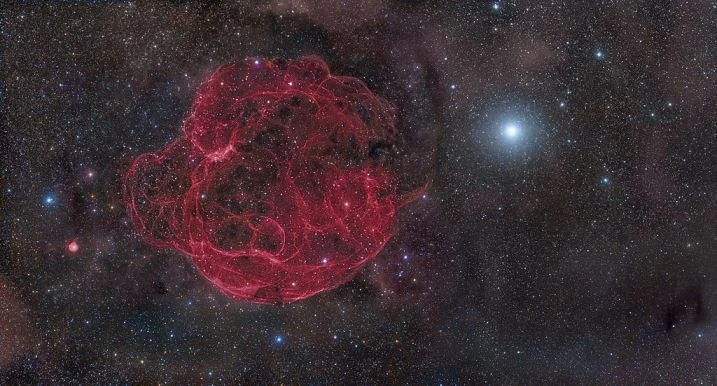
Elnath and the supernova remnant Simeis 147, image: Rogelio Bernal Andreo
Elnath can also be used to find the bright open star clusters Messier 36, Messier 37 and Messier 38 in Auriga. Messier 36 lies along the imaginary line extended from Elnath to Menkalinan. Messier 37 is found just east of the line connecting Elnath and Mahasim, about halfway between the stars, and Messier 38 is about a third of the way from Elnath to the bright Capella.
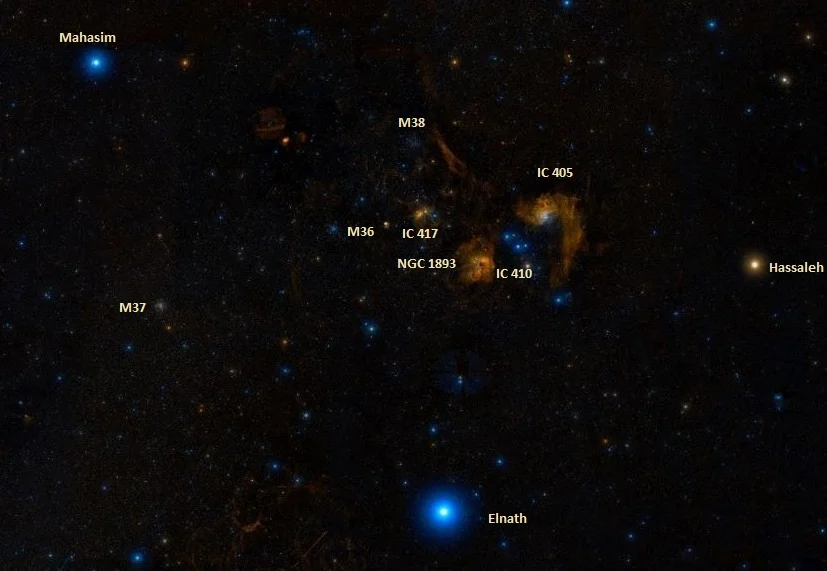
Mahasim, Hassaleh, Elnath, Messier 36, Messier 37, Messier 38 and the Flaming Star Nebula, image: Wikisky
Several other objects are located in the same region of the sky as M36 and M38. These include the Flaming Star Nebula (IC 405), an emission-reflection nebula surrounding the runaway star AE Aurigae, the emission nebula IC 417, the open cluster NGC 1893, and IC 410, the HII region that surrounds the cluster.
Constellation
Elnath is located in the constellation Taurus, the Bull. Known since ancient times, Taurus is best known for the bright Aldebaran, the 14th brightest star in the sky, and for its two bright open star clusters, the Pleiades (Messier 45) and the Hyades. The constellation also contains the historic supernova remnant Messier 1, also known as the Crab Nebula, the reflection nebula NGC 1555 (Hind’s Variable Nebula), illuminating the variable star T Tauri, and the planetary nebula NGC 1514 (Crystal Ball Nebula), located near the border with Perseus. The Crab Nebula (M1) appears near Tianguan (Zeta Tauri), the star that marks the Bull’s other horn.
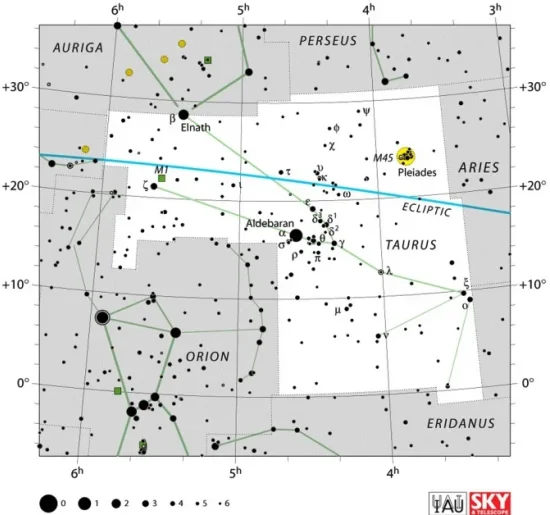
Taurus constellation map by IAU and Sky&Telescope magazine
The best time of year to observe the stars and deep sky objects in Taurus is during the month of January.
The 10 brightest stars in the constellation are Aldebaran (Alpha Tau, mag. 0.86), Elnath (Beta Tau, mag. 1.65), Alcyone (Eta Tau, mag. 2.87), Tianguan (Zeta Tau, mag. 2.97), Chamukuy (Theta2 Tauri, mag. 3.40), Lambda Tauri (mag. 3.47), Ain (Epsilon Tau, mag. 3.53), Omicron Tauri (mag. 3.61), Atlas (27 Tau, mag. 3.63), and Prima Hyadum (Gamma Tau, mag. 3.654).
Elnath – Beta Tauri
| Spectral class | B7III |
|---|---|
| U-B colour index | −0.49 |
| B-V colour index | −0.13 |
| Apparent magnitude | 1.65 |
| Absolute magnitude | -1.42 |
| Distance | 134 ± 2 light years (41.1 ± 0.6 parsecs) |
| Parallax | 24.36 ± 0.34 mas |
| Radial velocity | 9.2 km/s |
| Proper motion | RA: +22.76 mas/yr |
| Dec.: -173.58 mas/yr | |
| Mass | 5.0 ± 0.1 M☉ |
| Luminosity | 700 L☉ |
| Radius | 4.2 R☉ |
| Temperature | 13,824 ± 47 K |
| Metallicity | +0.08 dex |
| Age | 100 ± 10 million years |
| Rotational velocity | 59 km/s |
| Surface gravity | 3.65 cgs |
| Constellation | Taurus |
| Right ascension | 05h 26m 17.51312s |
| Declination | +28° 36′ 26.8262″ |
| Designations | Elnath, Beta Tauri, β Tau, 112 Tauri, HD 35497, HR 1791, HIP 25428, GC 6681, GCRV 3257, SAO 77168, PPM 94361, FK5 202, BD+28°795, CCDM 05263+2836, IDS 05200+2831 A, IRAS 05231+2833, 2MASS J05261751+2836271, WDS J05263+2836A, TYC 1859-1470-1 |